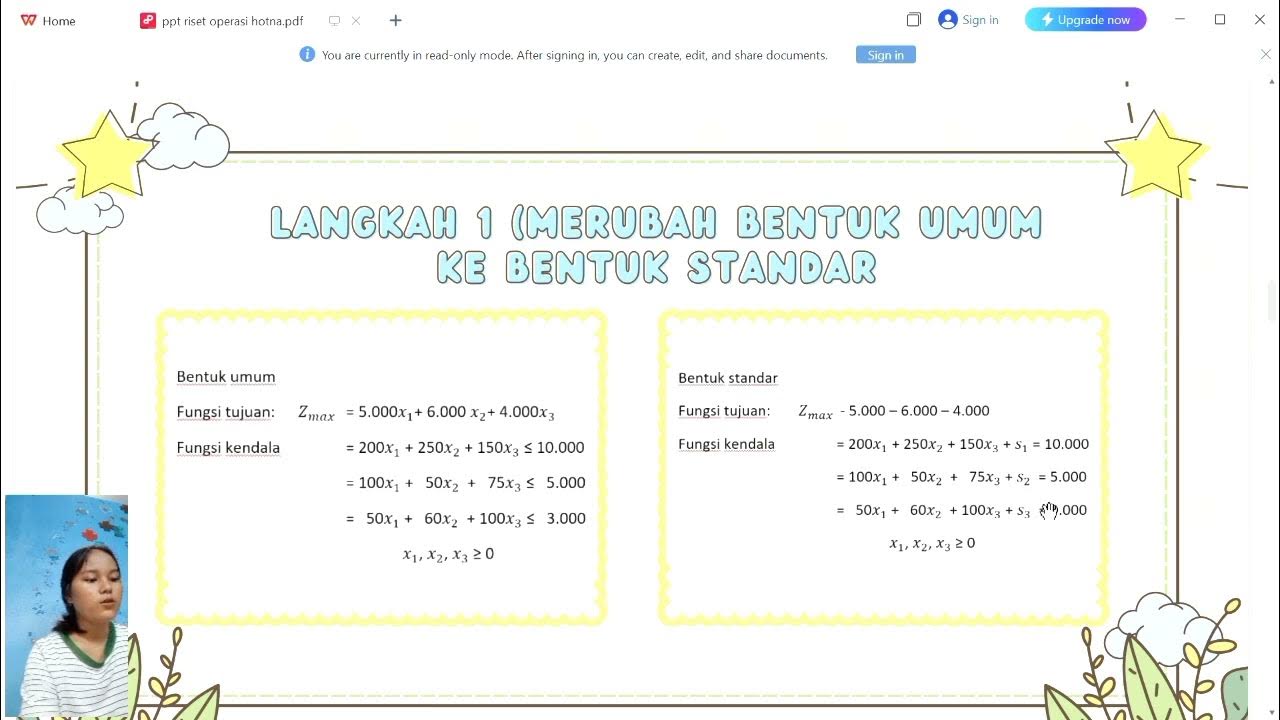PROGRESIONES GEOMÉTRICAS - Ejercicio 1
Summary
TLDRThis video script explains how to solve a problem involving a geometric progression. The first term is 3, and the common ratio is 2. The script walks through the steps of finding the fifth term and the sum of the first 8 terms. Using the formulas for the nth term and the sum of a geometric series, the fifth term is calculated as 48, while the sum of the first 8 terms is 765. The explanation is clear, highlighting the application of geometric progression formulas to solve real-world problems.
Takeaways
- 😀 The first term of the geometric progression is 3.
- 😀 The common ratio in the geometric progression is 2.
- 😀 The formula for the nth term of a geometric progression is: a_n = a_1 * r^(n-1).
- 😀 To find the 5th term, substitute the values: a_5 = 3 * 2^(5-1) = 48.
- 😀 The 5th term of the geometric progression is 48.
- 😀 The formula for the sum of the first n terms of a geometric progression is: S_n = a_1 * (1 - r^n) / (1 - r).
- 😀 To find the sum of the first 8 terms, substitute the values: S_8 = 3 * (1 - 2^8) / (1 - 2) = 765.
- 😀 The sum of the first 8 terms of the geometric progression is 765.
- 😀 When solving for the sum, ensure to handle the negative signs correctly, as r = 2.
- 😀 Both the formula for the nth term and the sum of terms are essential for solving geometric progression problems.
Q & A
What is a geometric progression?
-A geometric progression (or geometric sequence) is a sequence of numbers in which each term after the first is found by multiplying the previous term by a fixed, non-zero number called the common ratio.
What are the given values in the problem for the first term and common ratio?
-The first term (a₁) is 3, and the common ratio (r) is 2.
How do you find the nth term in a geometric progression?
-The nth term of a geometric progression can be found using the formula: aₙ = a₁ * r^(n-1), where aₙ is the nth term, a₁ is the first term, r is the common ratio, and n is the position of the term.
How is the fifth term (a₅) of the progression calculated in this problem?
-To calculate the fifth term (a₅), we use the formula aₙ = a₁ * r^(n-1). Substituting a₁ = 3, r = 2, and n = 5, we get a₅ = 3 * 2^(5-1) = 3 * 2⁴ = 48.
What is the formula for the sum of the first n terms of a geometric progression?
-The formula for the sum of the first n terms of a geometric progression is: Sₙ = a₁ * (1 - rⁿ) / (1 - r), where a₁ is the first term, r is the common ratio, and n is the number of terms.
How do you calculate the sum of the first 8 terms (S₈) in this problem?
-To calculate the sum of the first 8 terms (S₈), we substitute a₁ = 3, r = 2, and n = 8 into the sum formula: S₈ = 3 * (1 - 2⁸) / (1 - 2). Simplifying, we get S₈ = 3 * (1 - 256) / (-1) = 3 * (-255) / (-1) = 765.
What does the negative sign in the denominator of the sum formula signify?
-The negative sign in the denominator of the sum formula indicates that the common ratio (r) is greater than 1, leading to a series where terms grow exponentially. The negative denominator cancels out the negative result in the numerator, yielding a positive sum.
Why is the sum of the first 8 terms positive despite the negative signs in the formula?
-The sum is positive because the negative signs in both the numerator and denominator cancel each other out, resulting in a positive product.
Can the formula for the nth term of a geometric progression be used to find any term in the sequence?
-Yes, the formula aₙ = a₁ * r^(n-1) can be used to find any term in the sequence as long as you know the first term (a₁), the common ratio (r), and the position of the term (n).
What does the expression 'a₁ * r^(n-1)' tell us about the behavior of the sequence?
-The expression 'a₁ * r^(n-1)' shows how each term in the geometric progression is related to the first term, with each successive term being a multiple of the first term raised to a power determined by the position of the term in the sequence. The common ratio, r, determines whether the sequence grows or decays.
Outlines

Cette section est réservée aux utilisateurs payants. Améliorez votre compte pour accéder à cette section.
Améliorer maintenantMindmap

Cette section est réservée aux utilisateurs payants. Améliorez votre compte pour accéder à cette section.
Améliorer maintenantKeywords

Cette section est réservée aux utilisateurs payants. Améliorez votre compte pour accéder à cette section.
Améliorer maintenantHighlights

Cette section est réservée aux utilisateurs payants. Améliorez votre compte pour accéder à cette section.
Améliorer maintenantTranscripts

Cette section est réservée aux utilisateurs payants. Améliorez votre compte pour accéder à cette section.
Améliorer maintenantVoir Plus de Vidéos Connexes

Problem Solving using Polya's 4 step method|Tano, Arjyll B.

Matematika SMA - Barisan dan Deret (6) - Barisan Geometri, Rumus Un Barisan Geometri (A)

BISSETRIZ \Prof. Gis/

CRITERI DI CONGRUENZA DEI TRIANGOLI, criterios de congruencia de triangulos, triangoli congruenti

What Is The Area? HARD Geometry Problem

Program Linear Metode Simpleks Soal Cerita 3 Variabel
5.0 / 5 (0 votes)
